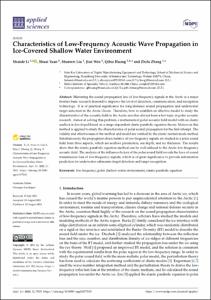| dc.contributor.author | Li, Shande | |
| dc.contributor.author | Yuan, Shuai | |
| dc.contributor.author | Liu, Shaowei | |
| dc.contributor.author | Wen, Jian | |
| dc.contributor.author | Huang, Qibai | |
| dc.contributor.author | Zhang, Zhifu | |
| dc.coverage.spatial | Arctic Ocean | en_US |
| dc.coverage.spatial | Polar Regions | en_US |
| dc.date.accessioned | 2023-04-20T05:19:08Z | |
| dc.date.available | 2023-04-20T05:19:08Z | |
| dc.date.issued | 2021 | |
| dc.identifier.citation | Li, S., Yuan, S., Liu, S., Wen, J., Huang, Q. and Zhang, Z. (2021) Characteristics of Low-Frequency Acoustic Wave Propagation in Ice-Covered Shallow Water Environment. Applied Sciences, 11:7815, 10pp. DOI: https://doi.org/10.3390/app11177815 | en_US |
| dc.identifier.uri | https://repository.oceanbestpractices.org/handle/11329/2182 | |
| dc.description.abstract | Mastering the sound propagation law of low-frequency signals in the Arctic is a major frontier basic research demand to improve the level of detection, communication, and navigation technology. It is of practical significance for long-distance sound propagation and underwater target detection in the Arctic Ocean. Therefore, how to establish an effective model to study the characteristics of the acoustic field in the Arctic area has always been a hot topic in polar acoustic research. Aimed at solving this problem, a mathematical polar acoustic field model with an elastic seafloor is developed based on a range-dependent elastic parabolic equation theory. Moreover, this method is applied to study the characteristics of polar sound propagation for the first attempt. The validity and effectiveness of the method and model are verified by the elastic normal mode method. Simultaneously, the propagation characteristics of low-frequency signals are studied in a polar sound field from three aspects, which are seafloor parameters, sea depth, and ice thickness. The results show that the elastic parabolic equation method can be well utilized to the Arctic low-frequency acoustic field. The analysis of the influence factors of the polar sound field reveals the laws of sound transmission loss of low-frequency signals, which is of great significance to provide information prediction for underwater submarine target detection and target recognition. | en_US |
| dc.language.iso | en | en_US |
| dc.rights | Attribution 4.0 International | * |
| dc.rights.uri | http://creativecommons.org/licenses/by/4.0/ | * |
| dc.subject.other | Elastic parabolic equation | en_US |
| dc.subject.other | Polar acoustics | en_US |
| dc.subject.other | Underwater acoustics | en_US |
| dc.title | Characteristics of Low-Frequency Acoustic Wave Propagation in Ice-Covered Shallow Water Environment. | en_US |
| dc.type | Journal Contribution | en_US |
| dc.description.refereed | Refereed | en_US |
| dc.format.pagerange | 10pp. | en_US |
| dc.identifier.doi | http://dx.doi.org/10.3390/app11177815 | |
| dc.subject.parameterDiscipline | Acoustics | en_US |
| dc.bibliographicCitation.title | Applied Sciences | en_US |
| dc.bibliographicCitation.volume | 11 | en_US |
| dc.bibliographicCitation.issue | 17, Article 7815 | en_US |
| dc.description.sdg | 14.a | en_US |
| dc.description.eov | Ocean sound | en_US |
| dc.description.maturitylevel | Pilot or Demonstrated | en_US |
| dc.description.methodologyType | Method | en_US |
| dc.description.methodologyType | Reports with methodological relevance | en_US |
| obps.contact.contactname | Li Shande | |
| obps.contact.contactemail | lishande@hust.edu.cn | |
| obps.resourceurl.publisher | https://www.mdpi.com/2076-3417/11/17/7815 | |
 Repository of community practices in Ocean Research, Applications and Data/Information Management
Repository of community practices in Ocean Research, Applications and Data/Information Management

